Day 71-76 Operation Desert Ride
Ready to go
It took a lot longer time to land in Aktau then we had imagined. When we finally were in port we were all ordered to get inside the ship. Border control police and customs officers came on board and checked the passports of the crew. A few hours later we were allowed to leave the ferry escorted by a police officer. We were led to an arrival hall and told to fill out some documents and line up for the regular inspection of our passports.

Since Wej and I were going to switch our passports here it was more exiting than the usual border passage. I went before Wej and showed the officer my other passport (not the one I used to exit Azerbaijan). It went well and I got my entry stamp and took a few steps forward and was stopped by a customs officer. He wanted to see me passport and asked me if I carried any narcotics or weapons and asked me to open one of my panniers. When he had taken a brief look through he told me to empty my pockets and then he found the passport I used to exit Azerbaijan. He was confused about me having two passports and took both of them back to the border control police.
I cursed myself for keeping it at such a foolish place as my pocket, but I needed to have it easily available if there would be any questions about why I didn’t have any exit stamp from Azerbaijan. Wej was standing behind me in the line and I told her to quickly hide her other passport.
One of the russians in the National Geographic photo team who were on the ship with us spoke excellent english and I asked him and the russian speaking german to come over to assist. They told the officer that it is very common in western countries to have two passports and explained that it was necessary if wanting to visit both arab countries and Israel.
After a while the border police officer came with my passports and said it was alright but that I shouldn’t show to anyone that I have two passports. Well – I actually didn’t show anyone, it was the customs officer who asked to see what I had in my pockets. What should I have done if I had hidden it in my sleeping bag and he had asked to see my sleeping bag?
The passport problem is anyway gone now since the next passport switch will be at the Thai border and then we are on our home turf and can explain in the right language if there should be any questions.
In many of the former soviet republics of central asia the demand for foreigners to register at the migration police is still in use. Since we were going to be in Kazakstan for more than 5 days we had to go and register. It took us about 3 hours to get a little extra stamp at our arrival cards.
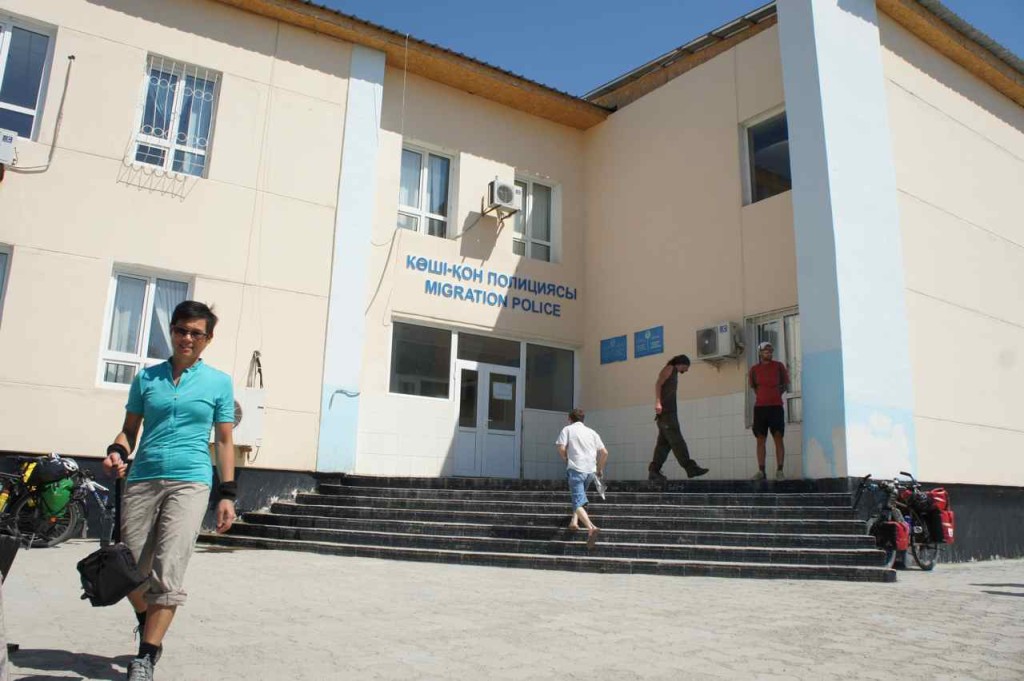
After having registered it was time to go and buy some supplies for the coming five days ride through the desert. We found a well stocked supermarket and we all bought lots of pasta and canned fish, meat as well as nutella and jam. Only high carbohydrate stuff….
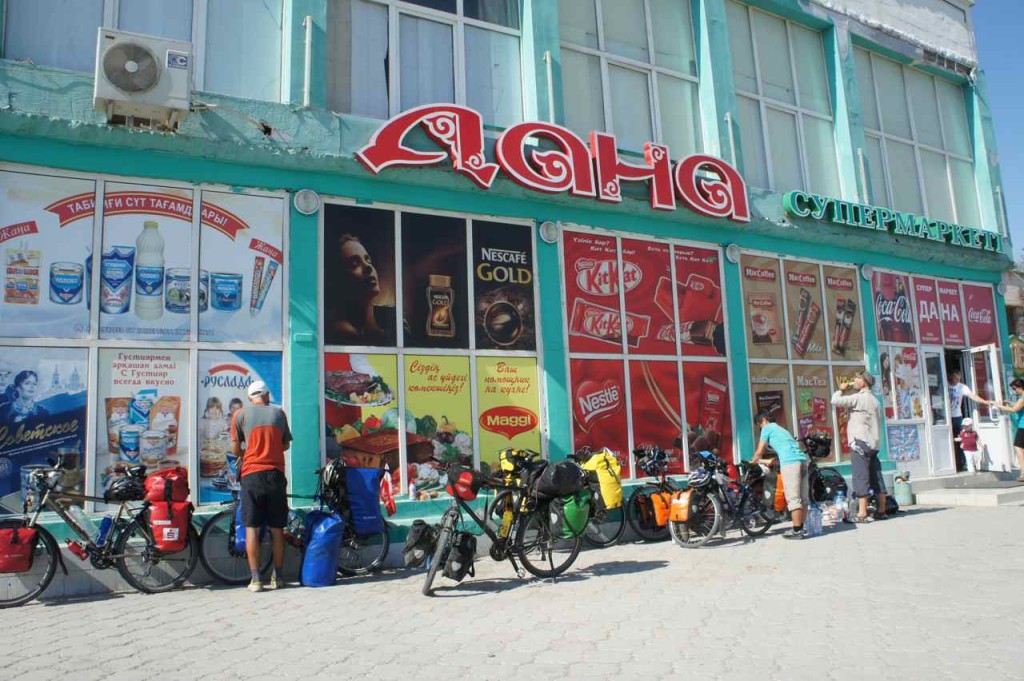
After getting our supplies we had a short discussion outside the supermarket which way to go from Aktau towards the town of Shetpe. There are two routes, one to the north and one to the south and after weighing for and against we decided to opt for the southern route.
Landscape
This part of Kazakstan is very flat and dry. I thought it should be a steppe but it turned out to be more of a desert. The ground is sandy or consists of hard burnt and cracked dirt with very little vegetation. The plants that grow are not higher than 20 cm and some of them have nasty thorns that are able to penetrate the floor in our tent. To avoid that we try to put our tent on bald areas and if there are any thorny little bushes we simply pull them up to make room for our tent. We also put our foam mattresses under the tent floor for extra protection.
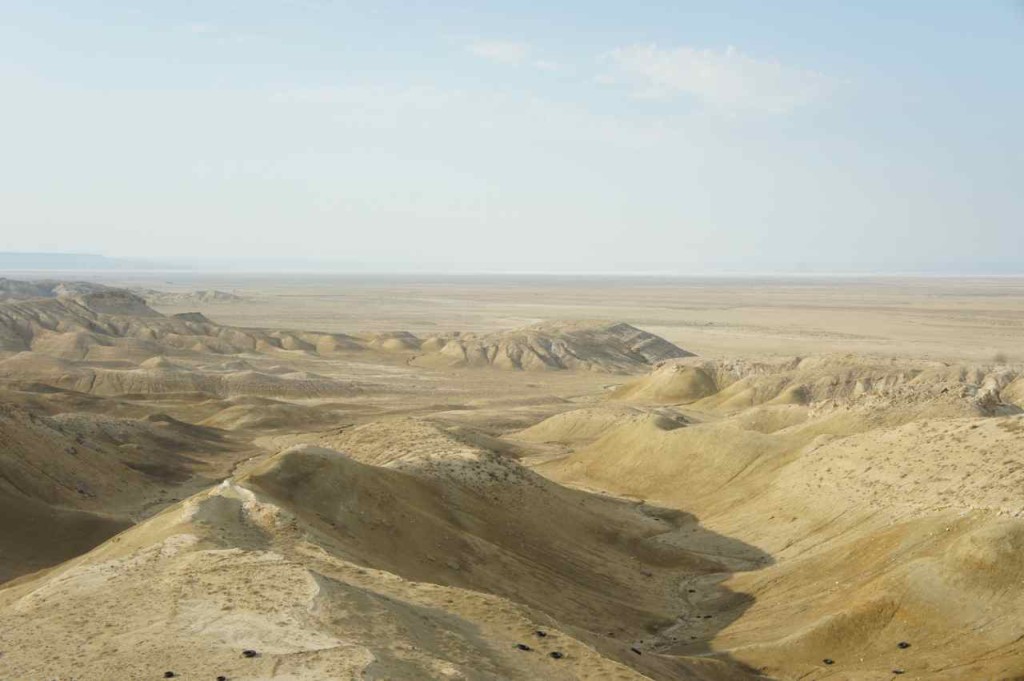
We have seen small scorpions living in the cracks on the ground and we are very careful when moving around and we have got a habit of turning shoes upside down and shake clothes before putting them on.
Apart from the scorpions we have seen lots of small desert rats that run quickly from one hole to the other. I don’t know what these little animals eat, but I bet the snake one of our friends saw feed on those rats.
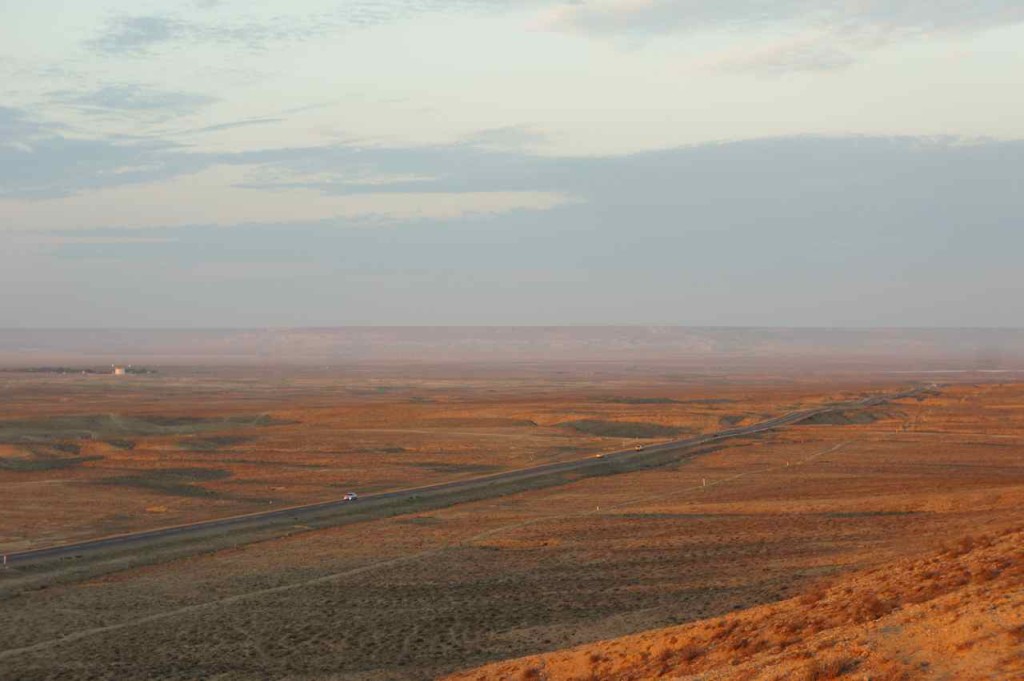
Camels and dromedaries are a common sight both in the desert and in the villages and towns. Some of them seem to have a marking indicating that they have an owner, while other seem to move around completely as they like. They walk on the road, beside the road and cars need to honk their horns to get them to move out of the way. Yesterday we saw a dromedary eating from the tree outside the hotel here in central Beyneu so they are just as common sight here as a pigeon in the park back home.

What we didn’t expect to see in the desert was horses. Large groups of up to 30 animals roam around in the areas where there is a little grass. I haven’t seen any markings on them and I don’t know if they are wild or have any owner. A camel must be of much more use in this kind of environment than a horse and maybe the horses are kept just for their meet.
Weather
The desert is hot. Actually it is extremely hot with temperatures going above 40 degrees. With no trees there is very little shade to find and our strategy has been to wake up at 5 AM and start cycling at 6.15 and continue until the heat is unbearable. Then we take a break somewhere where there is shade and continue to cycle for 2-3 more hours before looking for somewhere to camp.
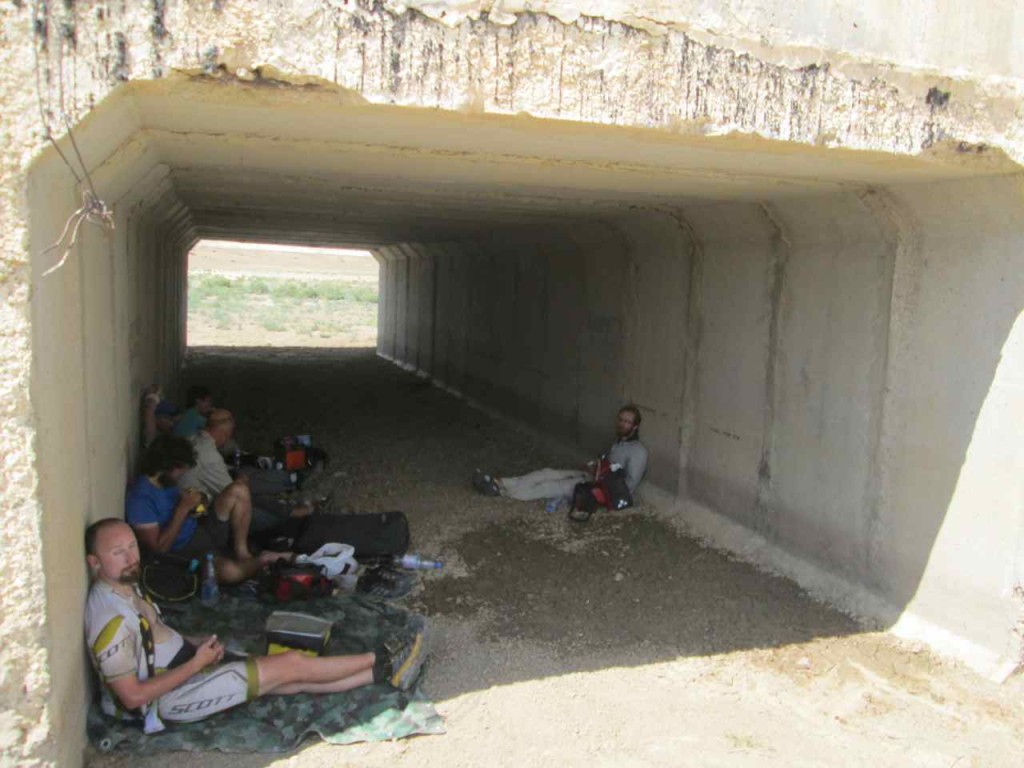
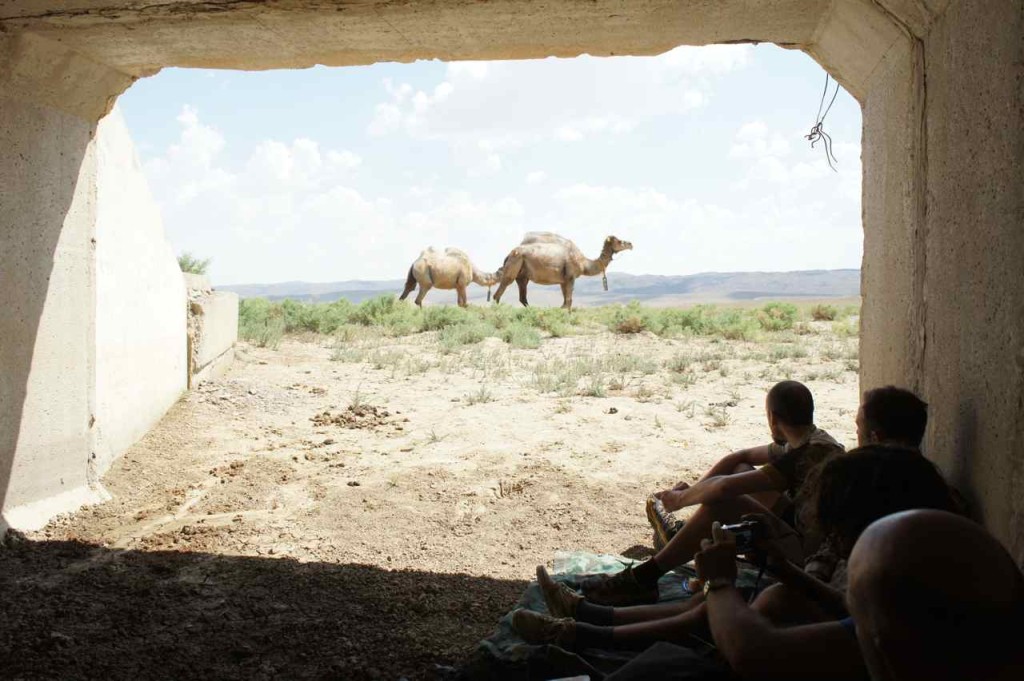
The second night in the desert we camped just below a small mountain ridge. We saw heavy clouds on the horizon and they came closer. When it was time to go to bed it actually started to rain. Not a heavy rain, but still a rain. When we woke up at 5 AM in the morning it was very windy and it had started to rain again so we decided to sleep one more hour before starting to cycle. At 9 AM the sky was clear and the sun was shining and it was hard to believe that the weather had been so nasty only 3 hours earlier.
When riding in the desert we need to protect ourselves from the merciless sunshine. I pull down my cap and use a buff to cover my neck and ears.
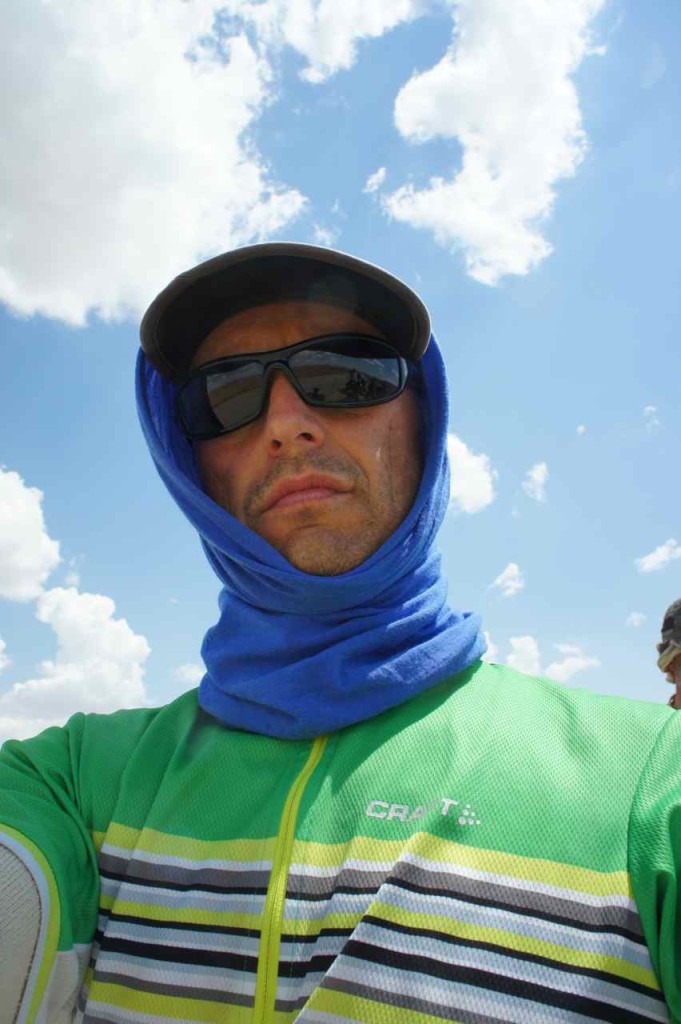
When dressed like this it is easy to start to think about how it was when we were caught in the blizzard in Hungary some three months ago.
Meetings in the desert
Eventhough it is a remote road there is some traffic on it. A lot of the traffic seems to be trucks going in both directions. The condition of the road surface very often made the trucks go very slowly and sometimes we cycled faster than they drive. One thing we noted was that the truck traffic was more intense during night time than during the day. I don’t know why it is like this and I think it is a real challange to navigate a truck on that really bad road during night time.
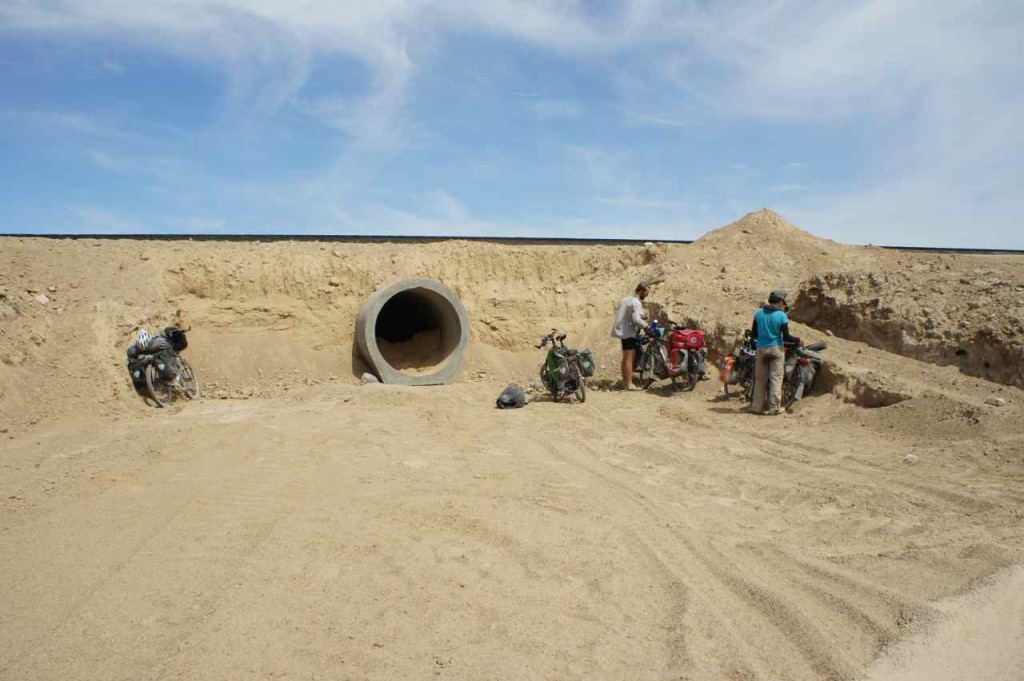
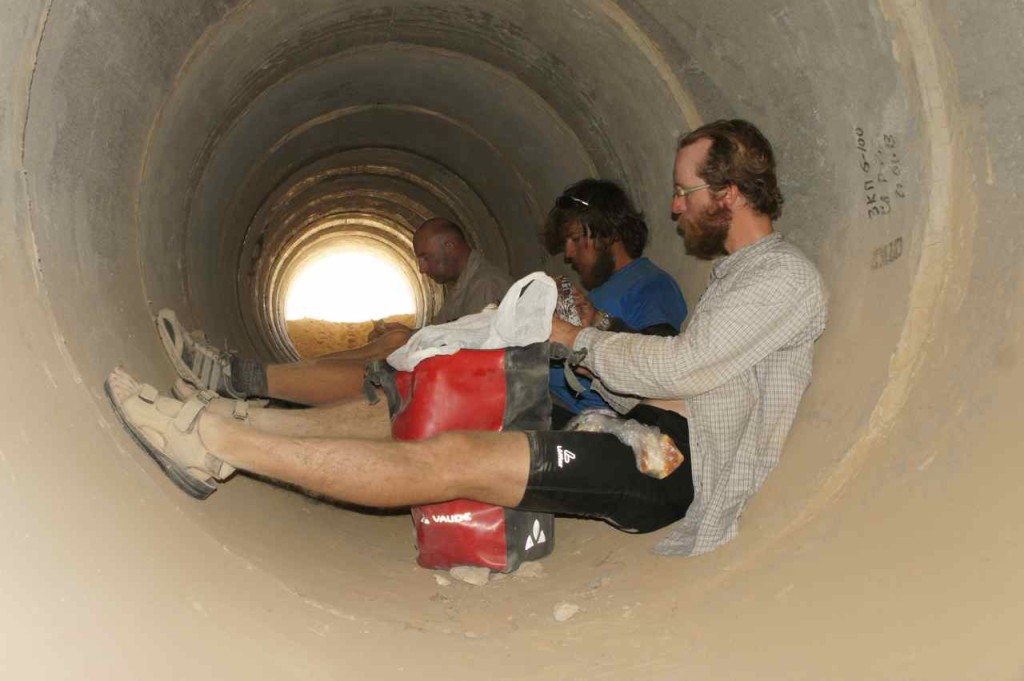
The truck drivers have been our friends on the road and we have had a couple of interesting meetings that are worth mentioning.
On day 3 we made a little detour from the road to ride into a village to buy more water and when we exited the town it was already time to start to look for somewhere to stay. When we came back to the main road we found a ”chaichana” (tea house) that also was a hotel. I went in to ask if we could stay there but the place was so lousy so we prefered to stay in our tents.
Truck drivers seem to like the tea houses and outside this one there were two large trucks from the American defense contractor Halliburton and a trailer with a RIB-boat with two large Evinrude engines. We must admit that we were confused about why someone would want such a boat in the middle of a desert.
We saw the Hallibruton trucks a couple of more times and one time they parked outside another tea house where we were resting and waiting for our two friends who cycled behind us. The drivers started to ask the usual questions where we come from and where we were going. We had no common language and after 20 minutes of talking we thought that they would give up. Then they started to order vodka and got a bit drunk and very pushy. When our two friends arrived after an hour we felt relieved and thought that they could take care of the drivers for a while.
Just like us our friends were asked where they come from and when the truckers heard that he is German the truckers got mad and accused our friend for nazism and made gestures refering to Hitler. It developed into a situation when one of the drivers threw a bottle at our German friend and we decided to back off and go camping somewhere out of sight from the tea house.
The following day we saw the Halliburton trucks a couple of times as they drove past us. We overtook them again when they had parked at a tea house and it seemed that these two truckers don’t go any further each day than we do on our bikes. I wonder what their bosses at Halliburton thinks about that.
On our the 4th day we were riding through a part of the road that was under re-construction. It was exceptionally dusty and we often had to wade through knee high piles of dust that was just as soft as powder. The sun was very hot and we were completely dusty when two trucks stopped in front of us and asked what we were doing.
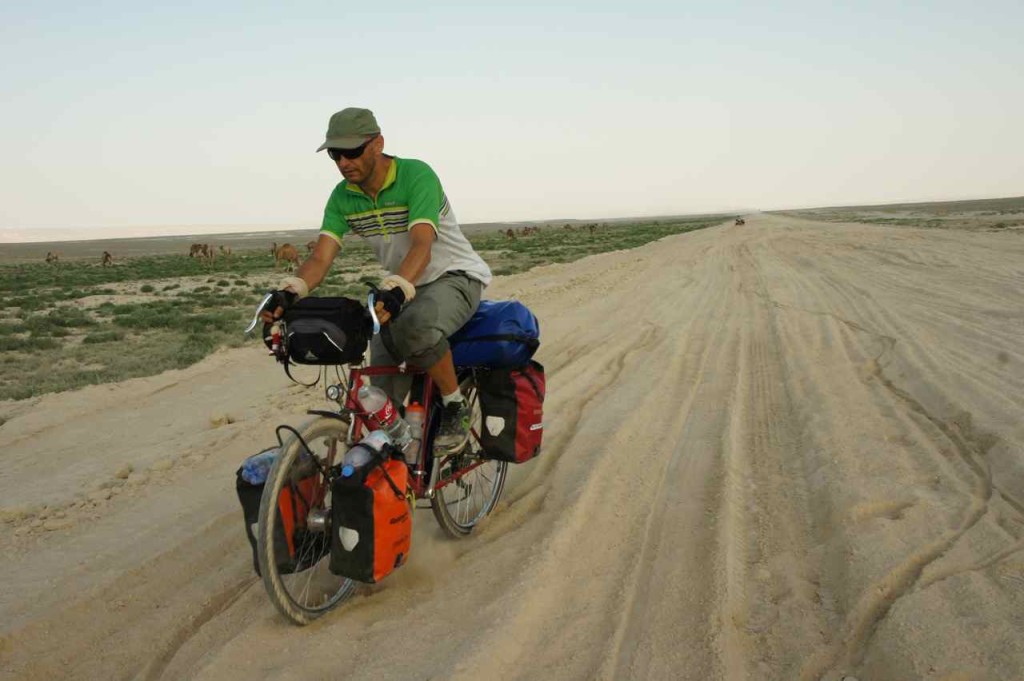
The drivers were turkish and told us they were on their way back from Bishkek to Istanbul. We told them we had been to Turkey and enjoyed it. Being turkish, the drivers asked if we needed anything like food or water and asked if we wanted some tea. I pointed towards the sun and said that I would prefer a cold coke and then one of the drivers ran back to his car and came back with a bottle of ice cold lemonade. Wonderful – and it reminded us once again of the hospitality we received in Turkey.
One night when we had set up our camp and shared what was left in a 0.2 liter bottle of vodka, our german friend said that he was sure that all the passing truck drivers had some vodka. He got up on his bike and rode towards the big road a couple of hundred meters away. After a while he came back followed by two large trucks that stopped just beside our camp. The drivers came from Dagestan in Russia and being close to the Caucasian mountain range they were wine drinkers. We spent some 15-20 minutes together and then they handed over a 5 liter bottle of home made red wine.
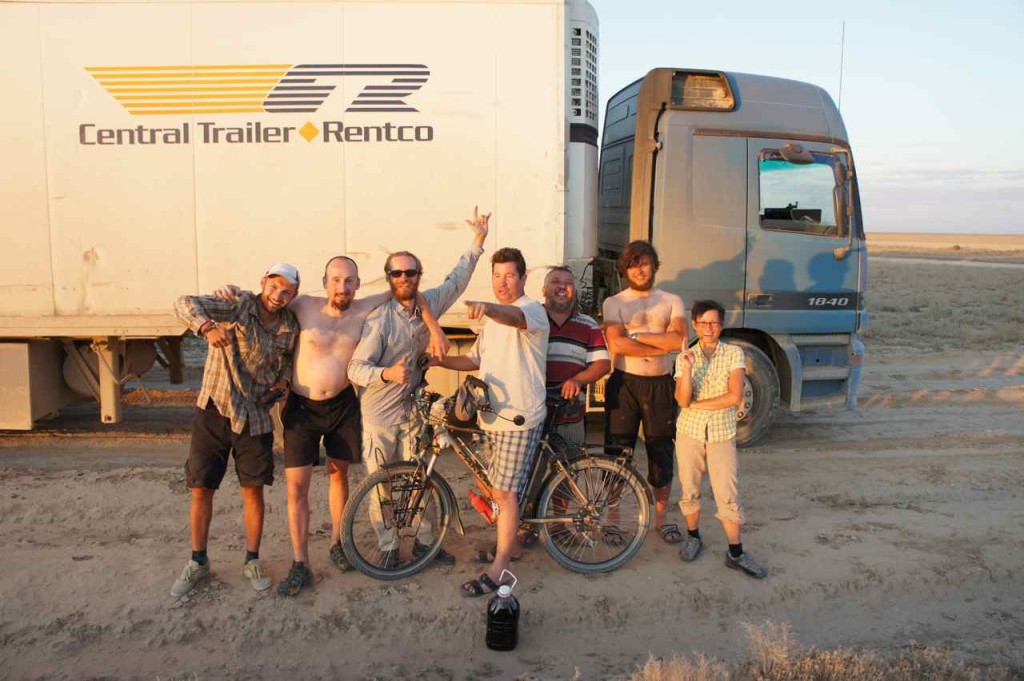
The wine tasted good, but since it was biking time at 6 AM the following morning I thought one single glass would be enough. Some of our friends had some more wine and I bet it can’t have been fun to bike through the desert with a hammering hangover.
Challanges
The lack of water became evident as soon as we entered the desert. We know where there are villages and tea houses where we can buy water but we still need to carry a lot and it makes the bikes heavy. The most water I have carried so far is 11 liters and that makes it hard when the road becomes sandy. The water also becomes more and more expensive the further into the desert we travel and our spendings on water makes up a large part of our expenses for the last few days.
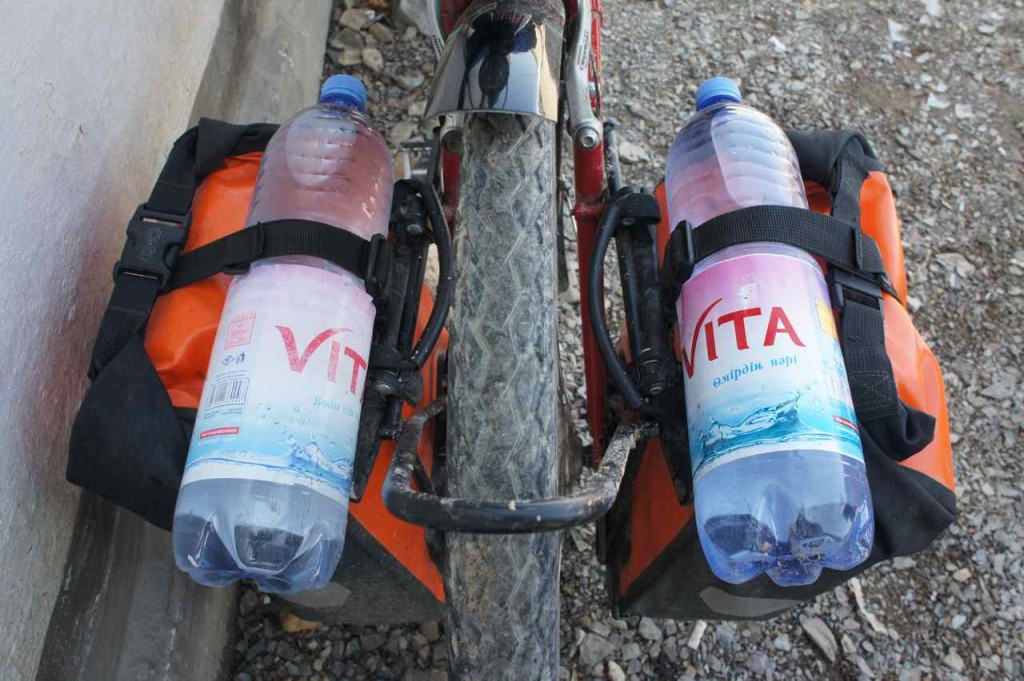
We need water to drink and cook food, but we also need to maintain some level of personal hygien. I allow myself somewhere between 0.5 to 1 liter of water for the daily shower. I wouldn’t say that it makes me clean like a baby, but it is enough to stay healthy.
Being together with six other people on very flat area with absolutely no trees and a clear view of 360 degrees means that one can’t be shy. If one wants to be without sight when going to the bathroom to shower or do other things, one will have to walk very very far. Shyness is not for the ones traveling together across the flat desert.

Arriving in Beyneu
There around some 30.000 people living in Beyneu so it is not a very large town at all. There are small shops along the main streets and there is a bazar. The town is located at a railway junction and the highway from Uzbekistan to Russia passes through as well as a number of pipelines. There seem to be a fair amount of professionals who come here to work with maintaining this infrastructure which means there are a few hotels in town. We decided long ago that we wanted to stay at one of the better ones and after almost a week in the hot and dusty desert with less than a liter of water for the daily hygien, it was great to be able to take a shower. Not only we needed a shower though, we washed all our clothes in the shower and cleaned the drive trains of the bikes as well.

Now we are prepared for the next section of this ride through the desert and we dont’t expect to be able to get online until Sunday when we expect to arrive in Nukus in Uzbekistan.
Toothpaste
In the grocery store next to the hotel they do sell Sensodyne toothpaste. We thought it could be a good idea to pick up some, but since that would add extra weight to our luggage and we still have toothpaste left, we decided to not buy here. I don’t know why I write this, but I think some of you might want to know…
Statistics for Cycling day 71
Distance: 41.4 km
Traveling time 6.41 hours
Cycling time 2.18 hours
Average speed 18.0 km/h
Top speed 28.8 km/h
Altitude gained 80 m
Altitude lost 61 m
https://www.strava.com/activities/63730457
Statistics for Cycling day 72
Distance: 107.9 km
Traveling time 12.29 hours
Cycling time 6.29 hours
Average speed 16.6 km/h
Top speed 38.5 km/h
Altitude gained 490 m
Altitude lost 337 m
https://www.strava.com/activities/63730467
Statistics for Cycling day 73
Distance: 85.6 km
Traveling time 11.59 hours
Cycling time 6.03 hours
Average speed 14.2 km/h
Top speed 50.4 km/h
Altitude gained 535 m
Altitude lost 651 m
https://www.strava.com/activities/63730454
Statistics for Cycling day 74
Distance: 88.1 km
Traveling time 11.32 hours
Cycling time 7.18 hours
Average speed 12.0 km/h
Top speed 23.8 km/h
Altitude gained 335 m
Altitude lost 154 m
https://www.strava.com/activities/63730431
Statistics for Cycling day 75
Distance: 88.1 km
Traveling time 12.44 hours
Cycling time 6.55 hours
Average speed 12.8 km/h
Top speed 18.7 km/h
Altitude gained 119 m
Altitude lost 202 m
https://www.strava.com/activities/63730390
Statistics for Cycling day 76
Distance: 90.4 km
Traveling time 8.30 hours
Cycling time 5.19 hours
Average speed 17.0 km/h
Top speed 27.7 km/h
Altitude gained 108 m
Altitude lost 230 m
https://www.strava.com/activities/63730377
Uzbekistan
We left the sandy town Beyneu on Tuesday july 2 and entered Uzbekistan on July 3rd (wednesday). We then raced the 436 km from the border to the town of Nukus in just 3 days. The internet connection here is very bad and although we have prepared posts we can not upload them. You will simply have to wait 2-3 more days until we arrive the silk road city of Khiva.
We are fine and Wejs knee works perfectly.
Wej & Joakim
